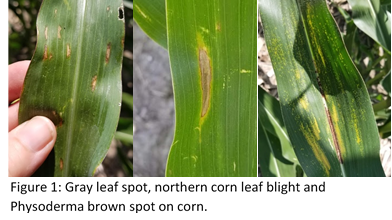Recent rains and increased humidity across Indiana have increased the risk for foliar diseases to develop in both corn and soybean. Much of the corn has begun to tassel and soybeans have begun to flower. We are starting to see common diseases in the lower canopy of corn, as we were out scouting this past week. A few diseases that I have seen included gray leaf spot, northern corn leaf blight, common rust, Physoderma brown spot and northern corn leaf spot in corn (Figure 1).
Diseases in soybean have been extremely low – I found a few frogeye lesions this past week. Since we are at R1 it is time to scout your soybeans for frogeye leaf spot. Management practices for frogeye are aimed reducing soybean susceptibility and inoculum availability. Infected debris from previous crops is the primary source of inoculum for this disease. Any practice that helps reduced or bury the infected residue will help reduced inoculum in a field such as fall tillage or soybean- corn crop rotation. There are a number of varieties available with frogeye resistance. Fungicide spray application after growth stage R1 can reduced severity, while applications made at R3 are considered most effective for frogeye. There are number of fungicides available to use for frogeye management see links below).
In addition, we are also tracking the activity of tar spot (map – see figure 2). On the map you can see gray areas where we have detected the disease in past seasons. The three yellow counties, Porter, LaPorte and St. Joseph are the areas where we have found active tar spot this season. Tar spot is still at a low incidence and severity in these fields. We are continuing to monitor them – as the hot, dry weather most likely slowed it down, but now that we have had some rain and long morning dews along with irrigation there is potential for the disease to start.

Figure 2. 2020 map of tar spot activity. Source https://corn.ipmpipe.org/tarspot-2/ and images of tar spot on corn.
Continue to scout your field to determine if any of these diseases are present. Gray leaf spot, northern corn leaf blight and tar spot are the diseases that are most commonly managed by fungicides in Indiana. For gray leaf spot and northern corn leaf blight fungicides applied at VT-R1 are most effective at preventing yield loss. Scouting will help determine the level of disease pressure in a field.
To make a decision for applying a fungicide there are four things I consider – 1. Disease risk in a field – do you have a previous history of the disease; 2. Current disease activity – do you find the disease in the lower canopy while scouting; 3. Weather conditions – will there continue to be favorable weather moisture and rain for foliar diseases? And 4. Return on investment – will the yield protected by a fungicide cover the additional cost of the application?
For fungicide recommendations please see the 2020 fungicide efficacy tables developed for both corn and soybean foliar diseases can be found at the following links:



